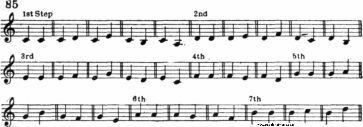EXTEMPORE PLAYING - online tutorial
40 Lessons in how to correctly play improvisations.
| Share page | Visit Us On FB |
|
Melody: Fundamentals 63 |
||
|
(2) Scale-steps, in accordance with natural tendencies—i.e., the 1st, 2nd, 3rd and 5th may rise or fall, the 4th must fall, the 6th must fall, and the 7th must rise.
(3) Narrow leaps (thirds), also in the natural direction.
Here are the same written out in notes: |
||
 |
||
|
It will be seen that with this very limited material a good deal of variety is possible.
The rhythm at present should be uniform, i.e., with one note to each beat.
Further developments will follow shortly.
Exercise 23.
(a) Play the various movements in Ex. 85, taking each one separately and sounding it twice over.
(b) Transpose the foregoing into every major key.
(c) Take the same in every minor key, observing that the 7th step will always remain major.
(d) Play four-measure phrases in six major keys, using the movements of 85, but introducing many repetitions. Be sure to commence with the first, third or fifth scale-step, and end with a perfect cadence, i.e., 2-1 or 7-8, with the final note on the accent. These phrases may be in duple or triple time, and may commence on any beat in the measure.
(e) Play similar phrases in six minor keys, remembering to supply the leading-tone, i.e., the raised 7th step. |
||